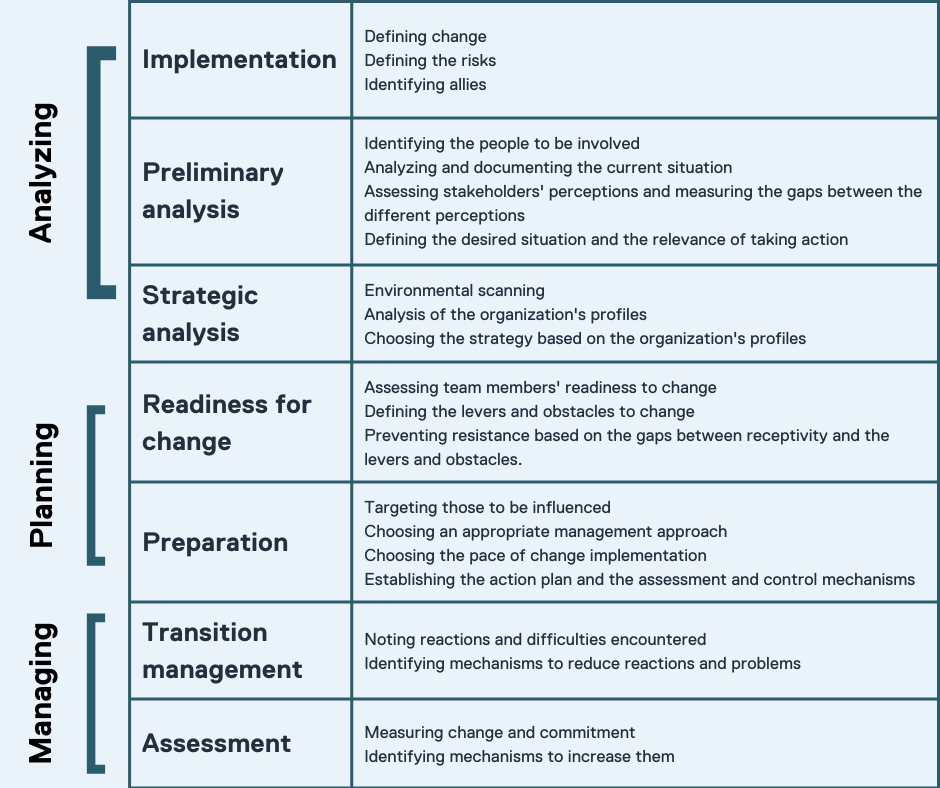Change management: a lever for improving organizational culture
There has been a lot of talk about the importance of organizational culture in recent years, especially when it comes to making changes that may affect an organization’s current culture. In fact, sometimes the culture of an organization can prevent the implementation of a change and create resistance. Obviously, this is not what is intended by implementing a change. An organization can still get away with it when a strong culture puts the implementation of a notable change at risk.
Positive or negative, organizational culture can create resistance
Let’s start by defining what an organizational culture is. It is a collection of values, attitudes, and ways of operating that characterize an organization and influence the practices of its members. This definition is therefore vague and comes from several potential sources. Culture can come from individuals themselves or from the practices within the organization.
We need to consider the impact of culture as being both positive and negative. For example, at EPSI, there is a very strong (and very positive) culture of meaning in the workplace, having clear expectations and two-way communication, having a shared vision and values, promoting commitment and benevolence. Since the early years of EPSI, these are the messages that the organization has been conveying. Employees adopted the expected values and behaviours or were hired because they had an affinity for those values and behaviours (in combination with their skills, of course!). It would be difficult to make a change today that would affect those same values. EPSI could not drastically change its approach overnight. There would probably be a lot of resistance!
The same is true for an organization whose members have been working in isolation for many years, with no communication from management and no collaboration between teams. If we tried to change the way we work overnight, even knowing full well that it would be a positive change, there would be resistance, and both would be difficult to change because of the culture of the organization.
So how do you go about making changes that will impact the culture of an organization or a work team?
The main point is that you must be patient and accept that it may take time… a long time. As an implementer of change, you have to be willing to put in the work and the energy. It is important to plan the change well, and not only with regard to time. Planning a change properly means that you must take the time to define it carefully and to analyze the organization or team that will experience the change. We have to anticipate the change by taking into consideration all the elements to be acted upon to ensure the success of said change, and develop strategies to achieve it. Finally, it is necessary to manage the change and the transition, assessing the impact of the change as it occurs and making the necessary adjustments (Collerette, Lauzier et Schneider, 2013).
To successfully implement change, you must be committed to it
The outline of the steps in Collerette, Lauzier, and Schneider’s (2013) model is reproduced in this summary table. This model clearly demonstrates that if you want to change the culture of an organization, you have to go through several steps and devote energy and time to it:

As we can see, it is not simply a matter of imposing a change on a work team, especially when the culture is strong and prevalent. Analysis and planning allow us to understand the current culture and to equip ourselves to gradually dismantle a culture that we want to change.
And what about communication?
Naturally, it is imperative to communicate throughout these stages, both with the stakeholders and with the people affected by the change. At each stage of change, communication enables us to raise awareness among the people concerned and to encourage them to see the benefits of the change and to wish to participate in it. Communication must be a two-way street. It often happens that a manager does not understand why employees do not adhere to the change, even though the manager has followed the necessary steps and taken the time to analyze and prepare their employees. It is important to understand on the one hand that an organization’s willingness to embrace and communicate change must be measured against those who are experiencing the change and their need to share their feelings about it. This balance is important, albeit fragile. We must give space without giving all of it. You have to engage your employees, while pointing them in the direction you want to go. You must take their opinions into consideration and consult with them, while being careful not to demobilize them if you do not go ahead with their ideas.
Dancing is about tuning up
It goes without saying that this process is somewhat like dancing. You adjust to each step along with your partner. It would be different with another partner too, or on another dance floor or to another melody! There are no miracle methods to apply step by step. You have to understand the basic principles and take the time to prepare and adapt for the rest!
References
1 Office québécois de la langue française (https://gdt.oqlf.gouv.qc.ca/ficheOqlf.aspx?Id_Fiche=8870886)
2 Collerette, P., Lauzier, M. et R. Schneider (2013). Le pilotage du changement, Québec, Presses de l’Université du Québec.
3 The summary table was created by the blog author, but the content comes entirely from Collerette, Lauzier, and Schneider’s (2013) model
4 Proverbe Provençal, Le dictionnaire des proverbes provençaux (1823)

